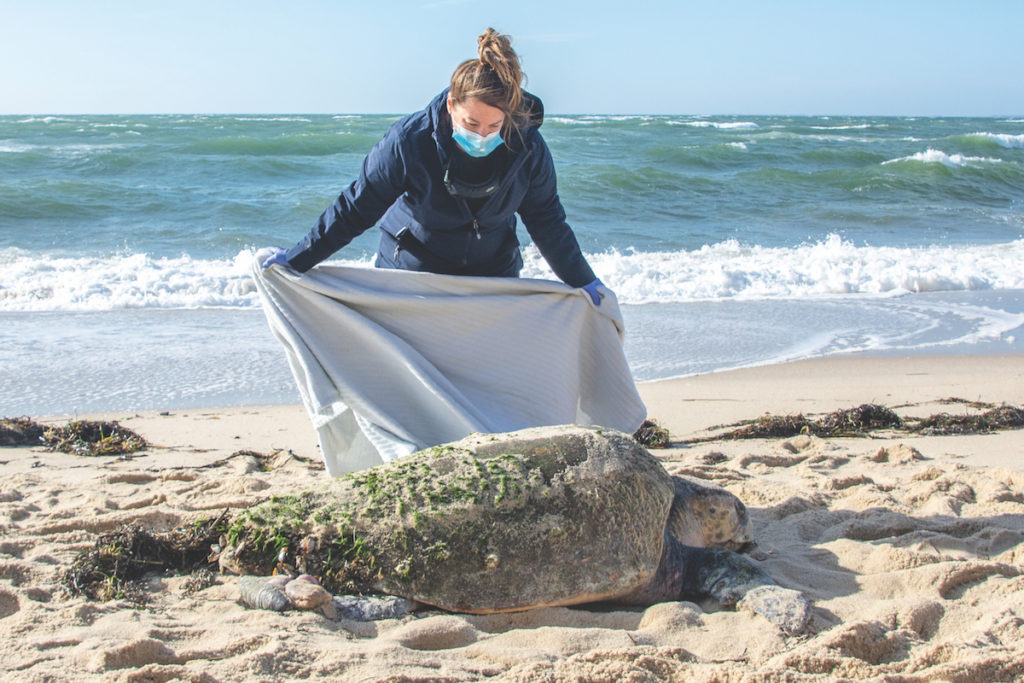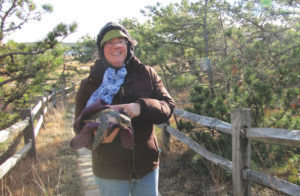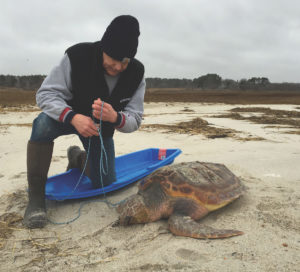
Thanksgiving week is a busy time for the sea turtle team at the Wellfleet Bay Wildlife Sanctuary and some 200 volunteers who work to rescue cold-stunned turtles on the Outer Cape. But a 350-pound loggerhead turned some heads when it was found north of Great Hollow Beach in Truro on Nov. 20.
The mature male turtle topped the size of a loggerhead named Munchkin, a 300-pounder rescued from Great Island in Wellfleet two years ago, according to Karen Dourdeville, Mass Audubon’s sea turtle stranding coordinator. Because of its size, it took the combined efforts of sanctuary staff and the Truro DPW, fire chief, and conservation agent to get the turtle from the beach to the sanctuary — a concerted response that Dourdeville said was “heartwarming and terrific.”

Sea turtle species regularly encountered here include Kemp’s ridleys, the smallest and most endangered; green turtles; and loggerheads. By now, all of them should be well on their way to the southern semi-tropical and tropical ocean habitats where they winter. But the turtles — especially juveniles — lose the ability to make their way to the Gulf Stream and head south when waters in Cape Cod Bay dip below 50 degrees F.
Strandings of adult turtles are uncommon, and for that reason researchers think the big loggerhead may have stranded because of some other health problem.
Bob Prescott, director emeritus of the Wellfleet Bay Wildlife Sanctuary, is the sea turtle rescue program director. Prescott and staff anticipate and plan for this annual event and are always well prepared. And although Covid-19 has introduced challenges into the well-oiled machine of turtle rescue, volunteer training took place on schedule in a virtual format on Oct. 21 and 24. With new protocols in place, seasoned rescuers were walking the beaches by the beginning of this month.
It is customary to patrol beaches just after high tide, because the turtles often wash up in the wrack — that line of seaweed and debris that accumulates on the beach at high tide. There is a sense of urgency about the work, because the turtles have a better chance of survival if they are not left on a cold windy beach for long periods of time.
Dourdeville said that strandings in 2020 started out at a slow pace, with the first major stranding occurring in Brewster, Orleans, and Eastham after strong northwest winds and heavy surf on Nov. 4. Then, with strong southwest winds during the week of Nov. 16, large numbers of turtles started washing up from Eastham to North Truro. Now, Dourdeville said, the year is shaping up to be a busy one. The loggerhead was one of more than 150 cold-stunned sea turtles to strand on Cape Cod in just three days.
To date, 245 turtles, mostly alive, have been found. The breakdown is as follows: 238 Kemp’s ridleys, 6 green turtles, and a single loggerhead. The stranding season continues into December.
Sea turtle volunteers are called to action when specific weather conditions are anticipated — and they’re not the ones that attract most people to the beach. We head out when it’s windy and cold, enduring sandblastings for the cause. (Full disclosure: I am one of the volunteers.) But we also take in some spectacular sunrises and sunsets while on turtle patrol. It is eerie yet also amazingly beautiful to be on a beach in the middle of the night.

When turtles are found, volunteers bring them above the high tide line and cover them with seaweed to protect them from the wind. They mark the area with an arrow in the sand or some type of distinctive marine debris and call the sanctuary hotline for further instructions.
Seasoned volunteers often carry a plastic sled so that, with permission from sanctuary staff, turtles can be towed off the beach to a nearby landing where they await pickup and transport to the sanctuary. There they are weighed and measured and given a preliminary health assessment before assigned drivers deliver them to the next stop in their rescue and recovery journey.
From Wellfleet, they are taken to the National Marine Life Center in Buzzards Bay or to the New England Aquarium’s turtle facility in Quincy. Some turtles recover quickly and can then be transported to points south for further rehabilitation and eventual release. Others, including those suffering from pneumonia or physical injuries, have a long road ahead of them and may spend an entire year or more in a turtle rehabilitation facility.
“Turtles Fly Too” is a group that coordinates and facilitates the activity of a group of general aviation pilots who donate their aircraft and fuel to endangered sea turtle rescue efforts. They fly rescued Cape Cod turtles to other locations with available rehab facilities. At least some lucky turtles get a one-way ticket south for the winter.
If you find a turtle on the beach, call the sanctuary: 508-349-2615, extension 6104.
Barbara Brennessel is professor emerita at Wheaton College and a sea turtle volunteer.



